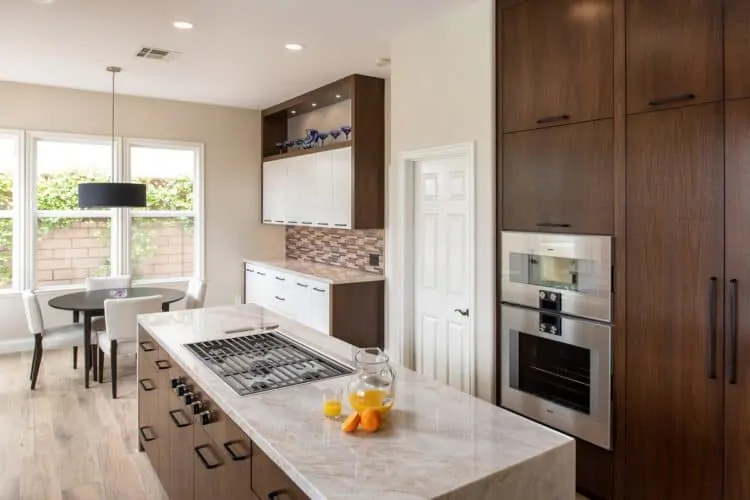
Kitchen Island or Peninsula: Which Is Better?
If you’re considering a kitchen renovation in San Diego, one of the first things you are going to need to do is decide what layout is best for your home. This often leads people to a common kitchen remodel debate: kitchen island or peninsula?
Unfortunately, it isn’t as simple as personal preference. Sometimes, a homeowner who really wants a kitchen island may not have enough space to fit one comfortably into their kitchen and living space. For others, a peninsula may not be ideal for the structure of their room.
To help you figure out whether a kitchen island or peninsula will work better for your home, we’ve created this comprehensive guide, in which we will dive deeply into the pros and cons of each style of kitchen layout, including their functionality, practicality, and, of course, price. Let’s get started.
Kitchen Island vs. Peninsula
Commonly referred to as the heart of the home, the kitchen is not only where you cook and eat, but where your family spends quality time together over meals. Many families spend more time together in their kitchen and dining area than in their living rooms. That’s why the design and layout of your kitchen have to be optimal for your living space — if they are off, your family may not be able to utilize the space to spend this time together.
The Kitchen Island
The kitchen island is the most popular kitchen layout. The island is just as it is in nature — a free-standing entity with no borders. When referring to the island in your kitchen, the island can serve a number of functions, including additional storage, counter space, a space for family and friends to sit, eat, and chat, and even where you locate your kitchen sink or oven and cooktop.
The kitchen island design is incredibly versatile and will become the centerpiece of the kitchen. Islands are great for snack bars during gatherings, can provide an additional area for food prep, and more. Islands can optimize your kitchen workflow by minimizing the time spent walking between prep areas and appliances. Foot traffic will be directed away from your work triangle and the island can provide a natural barrier between islands in your home.
Kitchen islands are ideal for L- and U-shaped kitchens. So should you add a kitchen island to your space?
Peninsula
A peninsula is very similar to a kitchen island, with one main difference: a peninsula is attached to a wall on one side, where the island is completely free-standing. The kitchen peninsula will serve the same purpose as a kitchen island but is an extension of the existing kitchen rather than standing alone. The peninsula is more popular in smaller kitchens, and easier to incorporate into the kitchen design.
The peninsula will help you improve your L-shaped kitchen space and act as a natural border between your kitchen and dining areas. Peninsulas are just as versatile as islands while taking up less space. You can also easily customize how big or small you want your peninsula to be.
Kitchen Island vs. Peninsula Deciding Factors
If we were to put together a Venn diagram to show you the characteristics of a kitchen island and a peninsula, the vast majority of their features would sit in the middle. Both are highly functional, create additional counter and seating space, and offer additional storage space. So how do you determine which one is best for your kitchen?
Much of the answer comes down to how much space you have available.
Your Kitchen’s Available Space
Both peninsulas and kitchen islands provide extra work space and an area for family and friends to gather and converse without being in the cook’s way. The kitchen work triangle stays open and ensures a good workflow.
However, sometimes the island can disrupt a kitchen’s work triangle, which is the space between the cooking area, sink, and refrigerator. If so, it is best left out. In other instances, the kitchen island may not provide enough space for people to easily pass by on all sides. In such cases, the peninsula is the better choice as it offers many of the same benefits of a kitchen island, but will allow for a more optimal work triangle.
A general rule of thumb is that a kitchen island should have at least 36 inches of clearance on all sides to allow people to easily pass by. There should also be a minimum of 42 inches for the workspace. Additional room may be required if the doors on the refrigerator, oven, or dishwasher open toward the island.
Meanwhile, a peninsula does not take up as much open space in the kitchen. Since it is an extension of the kitchen and attached to the wall, the peninsula can create a seating area for family and friends just like an island, but without the need for a gap in between. It all comes down to space and preference.
Islands and peninsulas can each come in a wide variety of sizes and be customized to fit the available space. An island can be as small as a butcher block or large enough to fit a cooktop, sink, and dishwasher, in addition to providing seating for four people. Another pro for having an l-shaped kitchen island is because of the extra storage and versatility. The peninsula can also simply be a food prep station or long enough to seat three at a breakfast bar.
In fact, it can be both, depending on how wide the space for the peninsula is. As you can see, there really are many different directions you can go with both the kitchen island and the peninsula. But generally, if you have less space to work with, the kitchen peninsula will be the better choice, as an island requires clearance on all sides no matter how small it is.
Personal Preference & Home Habits
When planning your kitchen remodel, you should also consider how you are going to use it. Islands fit perfectly into an open floor plan and will break up a large space without providing a clear border. Meanwhile, peninsulas will create a distinct border between your living space and cooking area.
If you are someone who entertains often or have a family who congregates in the kitchen, the island will often provide a better option, given you have the necessary space. The cook can engage anyone seated at the island while cooking much more easily in this setting.
On the other hand, if you prefer a bit of a barrier when you are cooking, the peninsula can shield you from foot traffic. You can also have a seated breakfast bar at your peninsula, but it will not be as open to the rest of the living space as an island would be.
Careful consideration into how you live your life and how you would like to interact with others while you cook is key to choosing the right kitchen layout.
Kitchen Layout & Design
The kitchen work triangle is so important that it is actually protected by the National Kitchen and Bath Association (NKBA). Any kitchen renovation must have a sum distance of no more than 26 feet between the refrigerator, stove, and sink. The NKBA also says that no “leg” of the work triangle should be more than nine feet or less than four feet long.
The kitchen layout therefore must offer plenty of space to operate and a clean path for cooks to move within the triangle and among the other elements. If the island disrupts this workflow, then it is not a good fit for the given space. However, if there is enough space, it actually frees up space and allows the cook to move between elements more efficiently.
Islands can either match the style and construction of the rest of the kitchen to create a cohesive look, with matching woodwork, handles, and countertops, or the homeowner may choose for the island to offer some contrast through a different color or design. This can act as a transition into the next room in an open-concept floor plan.
A peninsula has more limited design choices as it does not have this flexibility. A contrasting peninsula just looks odd if it does not match the rest of the kitchen. If the peninsula is added during a renovation, it can create some issues if an exact match cannot be found for the natural stone countertops. Often, this leads the homeowner to replace the entire countertops and/or cabinets, which adds to the expense of the renovation.
Installation Costs
Kitchen islands and peninsulas are most often added during a complete kitchen remodel, which means they will be just a portion of the overall cost. However, a kitchen island is typically more expensive, especially if you wish to have any appliances installed on the island.
A sink, small refrigerator, stovetop, or other appliance installed in the island will require electrical and plumbing to be added through the floor of the island. Due to the difficulty and price, these types of islands are best installed during new construction rather than during a renovation.
However, having these items included in the island is often what attracts homeowners to add them in the first place, so it may be deemed to be a worthy expense. Meanwhile, a peninsula most often does not have any appliances involved, and will not have any effect on the work triangle. This reduces the overall cost of labor and trade workers required, which makes a peninsula a (typically) much cheaper option.
Kitchen Island or Peninsula: Which Has a Greater Impact on your Resale Value?
Often, the motivation for a kitchen renovation is to boost the resale value of your home. Both can be great options to make your kitchen more attractive, however, the kitchen island holds the clear advantage here, as they are much more popular among today’s homebuyers. They also are much more expensive to install, so you may not recoup as much of the money you pay for the renovation as you’d like during the sale, but it may help you sell your home faster.
Overview of Pros & Cons
Let’s quickly recap each option.
Kitchen Island Pros & Cons
Pros:
- The more popular design element
- Accessible on all four sides
- Adds functionality to your kitchen
- Preserves the open room concept
- Has more design choices
- Can increase your kitchen’s amenities
Cons:
- Not a good fit for a small kitchen
- Requires significant space to be functional
- Difficult and expensive to add during a remodel
Peninsula Pros and Cons
Pros:
- The better option for smaller kitchens
- Adds functionality to an existing kitchen
- Provides accessibility to open floor plan
- Easier to add during a remodel
Cons:
- Limitations to flow in workspace
- Can create dead counter space in the corner where peninsula and cabinets meet
- May be difficult to match countertops and cabinets
- Slightly outdated in today’s home design
- Only one entrance and exit, creating potential traffic flow issues
Summary
While the kitchen island and peninsula are overall quite similar, there are clear differences that may make one or the other the better fit for your home. Before you begin your kitchen remodel, make sure you do your homework to see which style better suits your home. The professionals at Remodel Works will be happy to help you create the most beautiful and efficient kitchen possible.
Sources:
https://www.sandyspringbuilders.com/blog/kitchen-design-island-or-peninsula/
https://www.fixr.com/comparisons/kitchen-island-vs-peninsula
https://carlaaston.com/designed/kitchen-peninsula-or-island
https://www.houzz.com/ideabooks/170737/list/kitchen-layouts-island-or-a-peninsula
https://www.marrokal.com/choosing-between-a-kitchen-island-and-a-peninsula/











